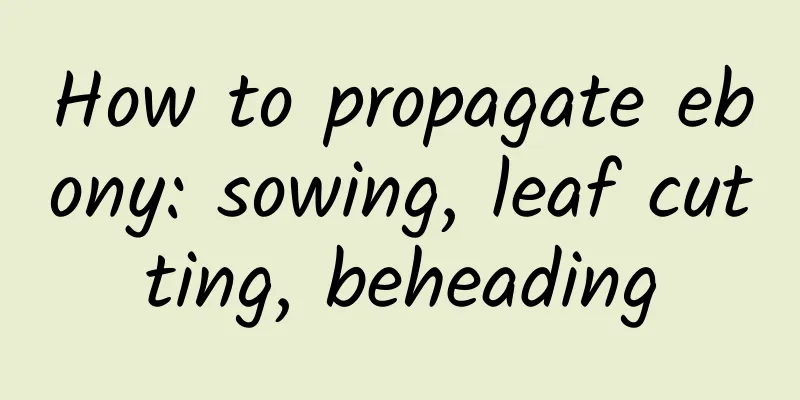When is the best season to plant noodles?

|
Noodle vegetable , also known as wheat bottle grass and mountain noodle soup vegetable, was a common wild vegetable in the past and is now cultivated artificially. Noodle dishes have a sweet and fragrant smell and are rich in nutrition, and have broad market prospects. So when is noodle vegetable planted? Let’s take a look with the editor below. 1. When is the best season to plant noodles? Noodles can be sown at any time on the balcony or in the greenhouse, and can be planted in spring and autumn, as long as it is not too cold and suitable for leaf growth. If you only want to eat the tender stems and leaves of the vegetable, you can choose mid-March to late April for outdoor spring cultivation, early September to early October for autumn cultivation, and you can sow at any time for greenhouse cultivation in winter. Because the seeds of noodle vegetables are small, their germination is easily affected when they come into contact with fertilizers . Therefore, fine land preparation should be carried out before sowing. Greenhouse cultivation is usually done in mid-to-late October, that is, after the previous autumn harvest. 2. Planting method of noodles 1. Land preparation Noodles are not very demanding on soil, but grow better in fertile and loose clay loam. Because the seeds of broccoli are small, their germination will be easily affected when they come into contact with fertilizer, so the land should be carefully prepared before sowing. Apply 30-45t/hm2 of fully decomposed finely crushed pig manure or human manure along with land preparation. Generally, chemical fertilizers are not used as base fertilizer. First, deep plow and harrow 2-3 times, then level it to make small raised ridges 10-15cm high and 100-120cm wide. For ease of management, greenhouse cultivation mostly uses north-south ridges. 2. Sowing method Noodles are all cultivated by direct seeding. They can be cultivated by row sowing or broadcasting. Noodles can be cultivated in a greenhouse. After sowing and before germination, keep the temperature at 20-25℃ during the day, not higher than 25℃, and 10-12℃ at night. Seedlings will emerge in 5-6 days. The ground film should be removed when about 70% of the seedlings have emerged. 3. Seedling management To prevent the seedlings from growing too tall after emergence, the temperature in the greenhouse can be lowered to 15-20℃ during the day. If it is higher than 22℃, the temperature should be ventilated in time and 8-10℃ at night. Before and after emergence, water should be irrigated frequently or sprayed with a watering can to keep the ground moist to prevent the soil from becoming compacted and affecting emergence. After emergence, the seedlings should be hoeed shallowly 1-2 times as soon as possible to promote root growth and strengthen the seedlings. 4. Fertilization management Noodle vegetables have entered a vigorous growth period. Due to their high planting density and high water demand, they should be watered frequently to ensure adequate supply of fertilizer and water to facilitate the growth of stems and leaves. When the seedlings grow to 2-3 true leaves, the first top dressing should be carried out, and 180-225kg/hm2 of nitrogen, phosphorus and potassium compound fertilizer or 22.5t/hm2 of decomposed dilute human manure should be applied with water. The second top dressing should be carried out 10-15 days later, and 150-225kg/hm2 of ammonium sulfate can be used. After each harvest, apply top dressing once, and the amount of fertilizer can be increased appropriately. The last top dressing should be done 7-10 days before harvest. 5. Chemical weed control After the seedlings emerge, they should be hoeed shallowly 1-2 times as soon as possible to promote root growth and strengthen the seedlings. At the same time, weeds should be removed as soon as possible to prevent them from affecting the growth of the noodles. 15-20 days before harvest, combine watering and topdressing, and spray the stems and leaves with 20-30 mg/kg of gibberellin, which has a good promoting effect on improving the quality of noodles and increasing their yield. The above is an introduction to the season for planting noodle vegetables. About 40 days after the emergence of noodle vegetables, when they have grown 10-16 leaves, they can be harvested in combination with thinning the seedlings. Generally, a small 2.5 cm wide oblique knife is used to pick the noodle vegetables.
|
<<: The correct way to water Dendrobium, can I spray the leaves when watering?
>>: How to store Dendrobium? Does dried Dendrobium have a shelf life?
Recommend
The difference between iris and iris
The difference between iris and iris flowers Flow...
How to get the highest survival rate of green radish by cutting? The fastest way to root green radish by cutting
The green radish is not only tenacious, but also ...
How often should nasturtiums be watered?
How often should nasturtiums be watered? Generall...
When is the best time to sow white radish seeds?
Radish seed sowing time Now white radish can be s...
What are the cultivation methods and precautions of bird's nest fern
Bird's Nest Fern Introduction Bird's nest...
When is the best time to plant snow peas?
Snow peas are a kind of vegetable that is eaten a...
Cultivation methods and precautions of pearl grass
Pearl grass is relatively easy to grow. Its leave...
Dragon fruit cutting season, are there positive and negative cuttings?
1. Cutting season The suitable season for dragon ...
Four seasons maintenance method of ball pine
Spring and Autumn Maintenance of Ball Pine Spring...
When does the desert rose bloom?
1. Flowering time If a flowering plant wants to b...
How to make daffodils bloom during the Spring Festival
Accurate breeding time Most people will buy finis...
The reason why the tips of camellia leaves turn black and fall off
1. Low temperature Reason: Camellia prefers a war...
Correctly understand the role of Milan flowers
Beautify your home Milan is a popular flower plan...
Can the mountain lotus leaf flower be grown at home?
1. Can it be domesticated? It can be kept at home...
The best time and method for transplanting gardenias and which months are suitable for transplanting
Gardenia is a common ornamental flower grown in m...









